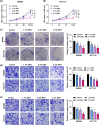Sevoflurane Suppresses the Proliferation, Migration and Invasion of Colorectal Cancer Through Regulating Circ_0000423/miR-525-5p/SGPP1 Network
- PMID: 35401845
- PMCID: PMC8938590
- DOI: 10.1007/s12195-021-00717-5
Sevoflurane Suppresses the Proliferation, Migration and Invasion of Colorectal Cancer Through Regulating Circ_0000423/miR-525-5p/SGPP1 Network
Abstract
Introduction: Sevoflurane (SEV) has been shown to inhibit the malignant progression in many cancers, including colorectal cancer (CRC). However, it is not clear whether SEV regulates the progression of CRC by mediating the circular RNA (circRNA) axis.
Methods: Different concentrations of SEV were used to treat CRC cells. Cell proliferation, migration and invasion were determined by cell counting kit 8 assay, colony formation assay and transwell assay. The expression of circ_0000423, microRNA (miR)-525-5p and sphingosine-1-phosphate phosphatase 1 (SGPP1) mRNA was measured by quantitative real-time PCR. Cell apoptosis was assessed using flow cytometry, and protein expression was measured by western blot analysis. Dual-luciferase reporter assay and RIP assay were performed to confirm the interactions among circ_0000423, miR-525-5p and SGPP1. Animal experiments were performed to explore the effect of SEV and circ_0000423 on CRC tumorigenesis.
Results: SEV could inhibit CRC cell proliferation, migration and invasion. Circ_0000423 was upregulated in CRC and its expression could be reduced by SEV. Overexpressed circ_0000423 reversed the inhibitory effect of SEV on CRC cell proliferation, migration and invasion and the promotion effect on cell apoptosis. MiR-525-5p could be sponged by circ_0000423, and its overexpression also abolished the regulation of circ_0000423 on the progression of SEV-treated CRC cells. In addition, SGPP1 was confirmed to be a target of miR-525-5p, and its expression was positively regulated by circ_0000423. MiR-525-5p inhibitor promoted CRC cell progression under the treatment of SEV, while these effects could be overturned by SGPP1 silencing. Furthermore, the inhibition effect of SEV on CRC tumorigenesis also could be abolished by overexpressing circ_0000423.
Conclusion: Our results showed that SEV inhibited CRC progression through the regulation of circ_0000423/miR-525-5p/SGPP1 axis.
Supplementary information: The online version contains supplementary material available at 10.1007/s12195-021-00717-5.
Keywords: Colorectal cancer; SGPP1; Sevoflurane; circ_0000423; miR-525-5p.
© The Author(s) under exclusive licence to Biomedical Engineering Society 2022.
Figures







Similar articles
-
Sevoflurane represses the progression of glioma by the regulation of circ_0037655/miR-130a-5p/RPN2 axis.Metab Brain Dis. 2022 Mar;37(3):787-799. doi: 10.1007/s11011-022-00906-9. Epub 2022 Jan 15. Metab Brain Dis. 2022. PMID: 35032276
-
Sevoflurane Regulates Glioma Progression by Circ_0002755/miR-628-5p/MAGT1 Axis.Cancer Manag Res. 2020 Jun 30;12:5085-5098. doi: 10.2147/CMAR.S242135. eCollection 2020. Cancer Manag Res. 2020. PMID: 32669871 Free PMC article.
-
Sevoflurane inhibits malignant progression of colorectal cancer via hsa_circ_0000231-mediated miR-622.J Biol Res (Thessalon). 2021 Jun 28;28(1):14. doi: 10.1186/s40709-021-00145-6. J Biol Res (Thessalon). 2021. PMID: 34183076 Free PMC article.
-
Circular RNA circ_0007142 regulates cell proliferation, apoptosis, migration and invasion via miR-455-5p/SGK1 axis in colorectal cancer.Anticancer Drugs. 2021 Jan 1;32(1):22-33. doi: 10.1097/CAD.0000000000000992. Anticancer Drugs. 2021. PMID: 32889894
-
Sevoflurane inhibits the malignant phenotypes of glioma through regulating miR-146b-5p/NFIB axis.Metab Brain Dis. 2022 Jun;37(5):1373-1386. doi: 10.1007/s11011-022-00959-w. Epub 2022 Apr 7. Metab Brain Dis. 2022. PMID: 35386035
Cited by
-
Unraveling the signaling network between dysregulated microRNA and mRNA expression in sevoflurane-induced developmental neurotoxicity in rat.Heliyon. 2024 Jun 20;10(13):e33333. doi: 10.1016/j.heliyon.2024.e33333. eCollection 2024 Jul 15. Heliyon. 2024. PMID: 39027541 Free PMC article.
-
Hsa_circ_0000423 promotes colorectal cancer EMT and immune escape by competitive adsorption of miR-369-3p mediating CCND1 expression.Discov Oncol. 2024 Nov 9;15(1):634. doi: 10.1007/s12672-024-01501-3. Discov Oncol. 2024. PMID: 39520607 Free PMC article.
-
Sevoflurane and Propofol Co-affect the Development of Colorectal Cancer by Regulating TM2D1.Comb Chem High Throughput Screen. 2025;28(10):1669-1678. doi: 10.2174/0113862073281046240527165415. Comb Chem High Throughput Screen. 2025. PMID: 38920064
-
Diagnostic and prognostic role of microRNA-525 in different cancers: a systematic review and meta-analysis.Transl Cancer Res. 2024 Aug 31;13(8):4301-4314. doi: 10.21037/tcr-24-383. Epub 2024 Aug 27. Transl Cancer Res. 2024. PMID: 39262458 Free PMC article.
-
LINC01234 Accelerates the Progression of Breast Cancer via the miR-525-5p/Cold Shock Domain-Containing E1 Axis.Dis Markers. 2022 Jul 25;2022:6899777. doi: 10.1155/2022/6899777. eCollection 2022. Dis Markers. 2022. PMID: 35923244 Free PMC article.
References
-
- Bao Y, Chen Z, Guo Y, Feng Y, Li Z, Han W, Wang J, Zhao W, Jiao Y, Li K, Wang Q, Wang J, Zhang H, Wang L, Yang W. Tumor suppressor microRNA-27a in colorectal carcinogenesis and progression by targeting SGPP1 and Smad2. PLoS ONE. 2014;9:e105991. doi: 10.1371/journal.pone.0105991. - DOI - PMC - PubMed
LinkOut - more resources
Full Text Sources
Miscellaneous

